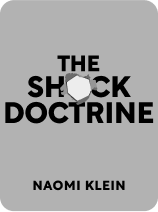

This article is an excerpt from the Shortform book guide to "The Shock Doctrine" by Naomi Klein. Shortform has the world's best summaries and analyses of books you should be reading.
Like this article? Sign up for a free trial here .
What is Naomi Klein’s The Shock Doctrine about? How does Klein define “disaster capitalism”?
The Shock Doctrine, by Naomi Klein, is a study of the history of economic shock therapy, which is a method of (supposedly) boosting a country’s economy through rapid deregulation, privatization, and severe cuts to government spending. It also examines how economic shock therapy gave rise to what Klein calls the disaster capitalism complex: a privatized system of destruction and reconstruction that funnels billions of dollars into corporate pockets.
Below is a brief overview of the key takeaways.
What Is Shock Therapy?
Briefly, economic shock therapy is a way to quickly improve a country’s economy through rapid privatization, deregulation, and severe cuts in government spending. In other words, it imposes strict free-market policies on the country in question as quickly as possible.
However, as Naomi Klein shows over and over again throughout The Shock Doctrine, this economic plan doesn’t improve an economy. Instead, economic shock therapy invariably leads to mass unemployment, increased poverty, and widespread starvation, while a few select people become extremely rich.
Shock Therapy and the “Clean Slate”
Naomi Klein’s The Shock Doctrine begins with a description of shock therapy as it’s traditionally known: A treatment for mental disorders wherein electric shocks are administered to a patient’s brain to intentionally trigger a seizure. The treatment was pioneered in the 1940s and 1950s by Dr. Ewen Cameron.
Cameron’s goal was to regress his patients’ minds to infancy, what he termed a “blank slate.” He thought that once all their current thoughts and memories were wiped away, he could easily reprogram them with new, healthy thought patterns.
However, while Cameron was very successful at breaking his patients’ minds, he was completely unsuccessful at rebuilding them. On top of that, many of his patients suffered from new and much more severe symptoms—both physical and psychological—than they’d shown before treatment. In short, Cameron fundamentally misunderstood what he was doing to his patients. He wasn’t wiping their minds clean—he was destroying them.
Disaster Capitalism
Disaster capitalism—taking advantage of disasters to push economic reforms that would otherwise fail—also can’t seem to distinguish between destroying and healing.
For example, when the US invaded Iraq in 2003, the Bush administration intended to completely destroy the existing Iraqi economy and build a radical free-market democracy in its place. However, no matter how much the US military blasted away at Iraq, they never managed to create that sought-after blank slate. As a result, they weren’t able to rebuild as the Bush administration intended.
We’ll discuss the Iraq invasion and its numerous failures in greater detail later.
The Chicago School’s Counter-Revolution
Disaster capitalism got its start in the famous University of Chicago’s Economics Department back in the 1950s under Milton Friedman. Friedman believed in unfettered capitalism. He maintained that in an unregulated economy, the natural economic forces of supply and demand naturally balance one another perfectly, leading to an ideal market wherein products are perfectly priced, everyone who wants to work can find a job, and inflation doesn’t exist. He believed that all economic problems are due to government interference in an otherwise perfect system.
Much like Cameron, Friedman believed that he needed to start with a blank slate in order to build this perfect economy. He dreamed of a country that was free from economic regulations, rules, and special interests, where pure capitalism could run its natural course. Also like Cameron, Friedman thought that the only way to reach such a state was through painful, destructive shocks to the country’s standing economy.
(Shortform note: To learn more about Milton Friedman’s ideas, read our summary of Friedman’s Capitalism and Freedom.)
Fighting the New Deal
From the 1930s to the 1950s, economies that blended capitalism with strong government regulation became popular. The most notable of them was Franklin Roosevelt’s New Deal. The world was prospering under these mixed systems, and things were good for the common folks. Those facts left Friedman and his free-marketeering colleagues with few supporters.
However, major US corporations were unhappy being forced to redistribute a lot of their money in the form of taxes and increased worker salaries. To counter this, they promoted Friedman’s policies.
(Shortform note: One of the major difficulties in discussing Friedman’s movement is that it has rebranded itself many times, often using terms that seem to have opposite meanings to one another. For example, Friedman called himself liberal—but his followers in the US associate that term with long hair and high taxes, and prefer to call themselves conservatives. The ideas that Friedman promoted would be called neoliberal in most of the world, but the American branch of this movement adopted the term neoconservative in the 1990s. In our guide, we’ll use the term neoliberal to describe Friedman’s policies.)
By any name, Friedman’s ideology was a three-part agenda that he believed would return the economy to its natural, healthy state:
- Governments must eliminate all laws and regulations that hinder corporate profits.
- Governments must sell off any assets that corporations could run instead.
- Funding for social programs must be drastically cut—or, ideally, eliminated.
Friedman’s economic strategy aimed to overturn New Deal policies and reset the American economy to how it was before the Great Depression. However, Friedman’s ideas were impossible to implement in America at the time. Even when Eisenhower—a hard-line Republican—took office in 1953, the New Deal’s programs were incredibly popular, and overturning them would almost certainly have cost Eisenhower his shot at re-election. Instead, neoliberals started looking abroad for easier targets.
The First Shock Treatment
Chile, not the US, would become the first testing ground for Friedman’s economic shock therapy. The Chicago School of Economics—with the backing of the US government—trained Chilean economists in Milton Friedman’s free-market orthodoxy so they could build a new economic system back in Chile based on Chicago School ideals.
Chile’s President Allende wasn’t interested in the Chicago-trained economists’ theories, preferring to run the country on a mixed system of capitalism with strong government regulation and social spending. Chilean general Augusto Pinochet, who overthrew President Allende in a swift and brutal military coup, adopted their ideas. Pinochet, a lifetime soldier with no economics training, knew that he’d need help handling the country’s economic affairs. Therefore, he turned to the economists of the Chile Project.
With the backing of Pinochet, the Chicago School-trained economists laid out this lengthy plan for the country bearing all the hallmarks of Milton Friedman’s teachings. It called for deregulation, privatization, and few government-funded social programs (if any). Now that Allende and his supporters were dead, imprisoned, or terrified into submission, the fundamentalists didn’t need to win popular support. Pinochet and his military government adopted the policy suggestions.
The Chilean “Miracle”
Pinochet held power for 17 years, from his coup in 1973 until he stepped down in 1990. Chile did experience years of steady economic growth under Pinochet, and after his death in 2006 many publications, including the New York Times and the Washington Post, praised his free-market policies and the economic miracle they’d created. However, the facts behind that “miracle” are deeply questionable.
Chile’s economic growth that the Times and the Post praised didn’t actually happen until the mid-80s, a decade after Pinochet tried Friedman’s economic shock therapy, and long after he’d radically changed course. The reality is that the Chicago School’s extreme free-market experiment was a disaster. Inflation skyrocketed, many people lost their jobs as the market flooded with cheap imports, and starvation quickly spread. The only ones benefiting from the shock therapy were foreign corporations and a few Chilean financiers who made a great deal of money on market speculation.
By 1982, Chile faced total economic collapse. Free-market capitalism had put all of Chile’s assets in the hands of speculators and financial institutions, who proceeded to run up a massive $14 billion debt. Inflation ran rampant while unemployment climbed to a crushing 30%.
In order to save his country, Pinochet had to do what Allende had done years before: Nationalize major industries and put a firm hand on the economy.
Despite the terrible results of this first experiment, Chile was the beginning—it was the Chicago School’s first major victory in the war to overthrow the New Deal and similar programs around the world. Although their policies didn’t improve life for the vast majority of Chileans, they did funnel wealth to the governmental and corporate elites. During the years of Pinochet’s shock treatment, 45% of Chileans fell into poverty, but the richest 10% of Chileans watched their incomes grow by an average of 83%.
The fast and free flow of money among the elites was like a drug for financial markets worldwide—rather than considering the awful cost of their experiment, or reassessing the free-market model, they immediately began looking for their next fix.
The Crisis Theory
The next major breakthrough for the Chicago School was the Crisis Theory: In simple terms, it meant leveraging a political or economic crisis to win public support, rather than pushing through the neoliberal agenda with brute force. Friedman noticed that people and governments are more receptive to dramatic economic policy changes after a crisis, which allowed an opening for his theories to be adopted.
The Crisis Theory was necessary because, although free-market economics spread quickly and brutally through South America, it had a harder time gaining traction in the US and Britain where democracy was more deeply entrenched, because people weren’t voting for politicians who tried to implement Friedman’s policies.
British prime minister Margaret Thatcher demonstrated how the Crisis Theory could advance Friedman’s policies during the Falklands War of 1982. It was an 11-week struggle between Britain and Argentina for control of the Falkland Islands which gave Britain an outside enemy. The people were swept away by a wave of nationalism and militarism, and they eagerly fell in line behind prime minister Margaret Thatcher. Her approval rating rocketed up from 25% to nearly 60%. Thatcher used her newfound popularity to impose neoliberal economic policies and government repression on a level that she’d told the Chicago School was impossible; for example, using police and government surveillance to squash a coal miners’ strike.
Debt Crises
Margaret Thatcher’s efforts in Britain proved that any sort of crisis could get the people to fall in line. Therefore, advocates of the free market reasoned, if internal crises could be leveraged as effectively as Thatcher leveraged the external crisis of the Falklands War, then they had a chance to fulfill their agenda after all.
Several influential economists noted in the mid-80s that hyperinflation was a type of crisis because it had many of the same effects as war: It created mass fear and confusion, displaced many people, and caused widespread loss of life. For the most orthodox of the Chicago School’s followers, this fact meant that hyperinflation wasn’t a problem to solve, but rather an opportunity to seize.
Ecological Crises
So far the crises that we’ve discussed have all been man-made. However, natural disasters are sometimes even more effective than wars or economic crashes.
The perfect example is December 26, 2004, when a devastating tsunami hit Sri Lanka and almost completely cleared the shoreline. Every hut and fishing boat was swept away in the storm, along with tourist cabanas and bungalows. Approximately 35,000 Sri Lankans died, and almost a million lost their homes—most of whom were small-boat fishers who relied on the sea to live.
This event, which was tragic for the fishers, was a golden opportunity for disaster capitalists. Once the rubble and bodies had been cleared away from the shoreline, they were left with pristine beaches all along the coast, ripe for development. Plus, the free-marketeers could use Sri Lanka’s time of need to make demands and gain concessions in exchange for aid. In short order, the country’s democracy was swept aside and replaced with a forum of ten wealthy Sri Lankan industrialists, who oversaw the “reconstruction.”
Iraq and the Disaster Capitalism Complex
In the early 1990s President George H.W. Bush’s Secretary of Defense, Dick Cheney, tried to bring the modern privatization craze to the US military. He decreased the number of active soldiers and increased the military’s reliance on private contractors like Halliburton. When Donald Rumsfeld joined President George W. Bush’s cabinet as Secretary of Defense in 2001, he continued Cheney’s work. He started laying off huge numbers of troops and personnel and hiring outside agencies like Halliburton and Blackwater to take up the slack in order to create a fully outsourced “hollow shell” government. Under this model, the government’s only role would be to hand out contracts to private companies, which would—supposedly—handle tasks more effectively and efficiently than a large government ever could. This was the birth of the modern disaster capitalism complex: a sprawling system whose only purpose was to funnel government money into corporate pockets.
The War on Terror
Bush and Rumsfeld got the chance to realize their dreams due to a national tragedy: the terrorist attacks of September 11, 2001. The attack provided a common enemy for the people to rally against, and a justification for anything the government did to fight back.
So began Bush’s infamous “War on Terror.” While it was supposedly an effort to defeat terrorism around the world, in practice, it was a smokescreen to build a privatized police state, both at home in the US and abroad in the Middle East. Large sections of the economy, ranging from disaster reconstruction to war and homeland security, were turned over to private contractors.
The Bush administration’s foreign agenda was even more extreme. The US attacked Iraq in response to 9/11 and subjected the people there to violent military shocks.
Then came the economic shock therapy. The Bush administration thought that they’d finally found their “clean slate” and planned to build their perfect free-market economy from the ground up.
However, they ran in trouble on two fronts. First, they were unable to create an effectively clean slate. The occupying forces met violent resistance at every turn. They responded to violence with further violence of their own, and the entire country spiraled into a war of attrition.
Second, they were unable to build a new, functioning economic system. The CPA—Coalition Provisional Authority, Iraq’s interim government—was so understaffed and had so few resources that it couldn’t even begin building the economy that the Bush administration dreamed of. For example, they had only three people assigned to privatizing state-owned factories; by contrast, East Germany had around 8,000 when it undertook the same task.
Ironically, this failure was due to the CPA’s devotion to Chicago School fundamentals. After all, minimizing government spending is a cornerstone of free-market capitalism, but in this case, it meant that they didn’t have the money or resources to do their jobs. Additionally, the CPA staffers’ hatred of all things governmental meant that what they were trying to do—build a new state from the ground up—went directly against their beliefs.
The Davos Dilemma
The ongoing shock treatments around the world culminated in a disturbing realization at the 2007 World Economic Forum.
For many years, people had believed that stability and peace were necessary for steady economic growth. The Forum, however, was puzzled by a global trend that seemed to buck this common knowledge. The world had been rocked by a near-constant series of shocks, beginning with the stock market crash of 2000 and the terrorist attacks on September 11, 2001. Despite that, the global economy was growing at an incredible rate.
The logical conclusion was that the economy no longer relies on stability—quite the opposite, in fact. Corporate profits all over the world are actually increasing in the face of sustained conflict and repeated disasters.
This conclusion correlates directly with the rise of the massive, multipurpose disaster capitalism complex of the 2000s, where massive contracts were granted to private firms in every industry from fuel to construction—and, of course, security and defense.
Conclusion: Recovering From Shock
As we’ve seen, free-market policies always result in a huge transfer of wealth and power from the lower economic classes to the upper ones. That transfer never happens peacefully, and in many cases, it doesn’t happen legally. That’s why free-market crusaders have to shock countries into submission: Their economic reforms can only go through when the people are too exhausted or stunned to fight back.
However, by its very nature, shock eventually wears off. For example, in 2001, Argentina—a former shock therapy laboratory—ousted a series of five presidents in three weeks, all while demanding freedom from the Chicago School’s policies.
Lebanon similarly rejected foreign aid—and the economic shock therapy attached to it—in 2006. Despite being deeply in debt and desperate for funds, Lebanese economists and some political leaders recognized that all of the profit would go to the disaster capitalism complex, while all of the hardship would fall upon their own people. General strikes and protests erupted all over the country in response to the proposed shock therapy, and the economy came to a screeching halt.
Recovering as a Community
However, even as people recover, they face daunting obstacles in reclaiming their countries. Perhaps the biggest problem of all is that they now have to rebuild entire communities from the rubble that economic shock therapy left behind, and they have to do it largely without foreign aid. Nonetheless, there’s cause for hope: communities all over the world are already doing it.
For example, Thailand was hit by a tsunami similar to the one that devastated Sri Lanka. However, unlike Sri Lanka, the Thai people rebuilt their own settlements and fishing communities, often within mere months.
In Thailand—and everywhere else that citizens have bucked the disaster capitalism complex by taking reconstruction into their own hands—people say that they’re not just healing their communities, but themselves as well.
That’s because shock is, in essence, a feeling of powerlessness; people feel like they’re being swept away by forces that they can’t hope to resist. Therefore, rebuilding their own communities is an expression of their personal power and a rejection of that helplessness.
The reconstruction efforts also wholly reject the endless quest for clean slates upon which to build model civilizations. These people aren’t starting from scratch but from the ruins of their old homes. They make do with whatever tools and materials they can salvage, and their only ideologies are community and practicality. As we’re now seeing, communities can join together to support each other and rebuild, rather than waiting for external aid that comes with ulterior motives. These communities are coming back quickly, efficiently, and—most important of all—durably; the people won’t be taken in again by the false promises of economic shock therapy and disaster capitalism.

———End of Preview———
Like what you just read? Read the rest of the world's best book summary and analysis of Naomi Klein's "The Shock Doctrine" at Shortform .
Here's what you'll find in our full The Shock Doctrine summary :
- A study of the history of economic shock therapy
- How economic shock therapy gave rise to the disaster capitalism complex
- How communities are beginning to recover from the destructive shock treatments






